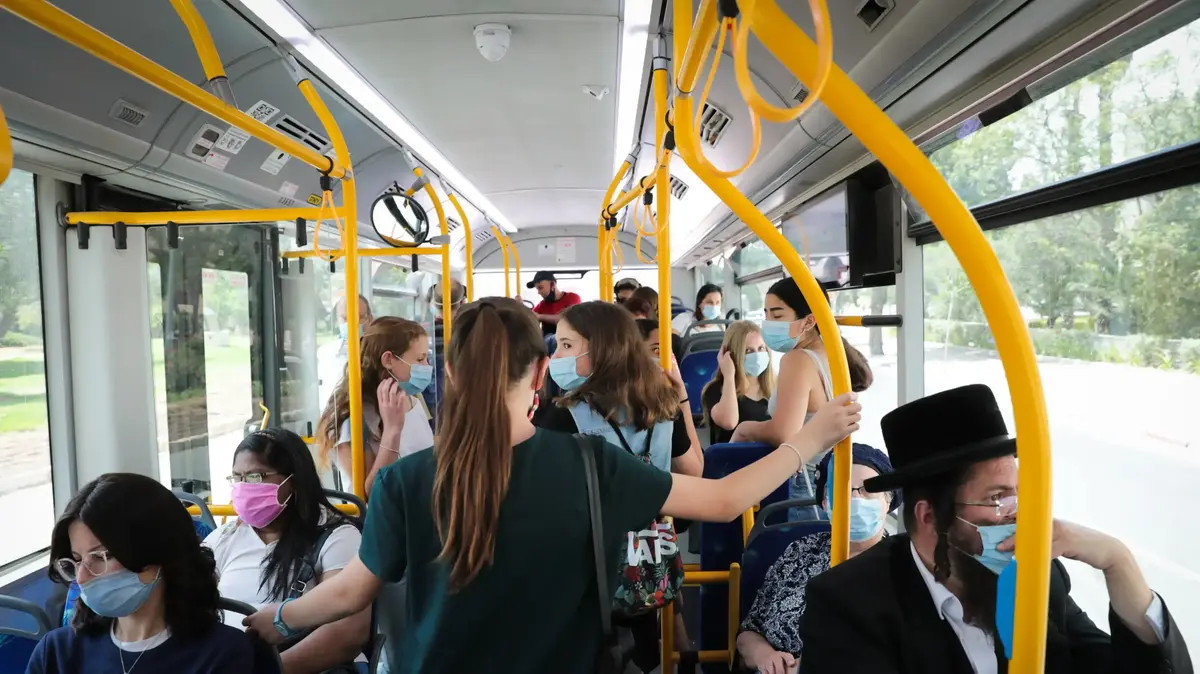What will make it better, and where will you be more satisfied with it?
The Great Public Transport Survey
The survey, conducted among about 4,000 Moovit users, examined the level of passenger satisfaction with public transportation in the country.
Among other things, the respondents were asked about the lateness of the line, the incompatibility of the bus with the line, and also what would make them switch from the private vehicle to the bus or train.
Keenan Cohen
05/01/2022
Wednesday, 05 January 2022, 06:11 Updated: Thursday, 06 January 2022, 08:48
Share on Facebook
Share on WhatsApp
Share on Twitter
Share on Email
Share on general
Comments
Comments
In the video: Minister of Transportation Michaeli on a solution to the soldiers' load on public transportation (Photo: Knesset Channel)
Half of the 15 public transportation activities in Israel, including Metropolis, Kavim, Dan, Electra-Afikim and Egged Transport, received a score lower than the national average, in a survey that examined satisfaction with the use of public transportation in Israel, according to the electronic control report for August-October 2021 About 4,000 users of the Moovit public transportation app participated in the survey.
In a report published by the National Authority for Public Transport, the scores they received from public transport activities throughout the country are published according to indicators such as lateness of the line, non-execution, deviation from the line and non-compliance of the bus with the line.
Against the background of these data, it is interesting to see the results provided by the Public Connection Survey whose findings are published here for the first time.
Data indicating a reasonable level of satisfaction of users of public transportation in Israel from it.
In the survey, 58% of respondents live in the central area, 54% of them use it daily, and definitely in favor of the metro project - these are just some of the findings from the public transportation survey, which included about 4,000 users of the Moovit public transportation app. .
Moovit is part of the Intel Group, and with more than a billion users in 3,400 cities, is improving the experience of using public transportation by improving the data from six billion anonymous information points per day, and is working with Mobilai in the effort of Intel to accelerate the transition to autonomous transportation.
More on Walla!
Dozens of buses and refreshment stations: The IDF's new transportation system is underway
To the full article
More on Walla!
There have been no trains on weekends and in the evenings for more than a year, and passengers are lost
From eight passengers or more: Minister Michaeli's solution for public transportation on Saturday
The amazing mistake we have all made to date in buying a mattress for a bed
In the periphery are satisfied, in the center less
So what do public transport users think about its level of service? 52% of the respondents said that the level of service has not changed, 27% answered that the level of service has decreased compared to 19% who say that the level of service has actually improved. The division into geographical areas shows that among the residents of the center there is a majority of those who claim that the level of service has decreased compared to those who claim that it has improved - 30% versus 16% respectively.
Outside the central area, satisfaction with public transportation is actually higher. 20% of Jerusalem residents, 26% from Haifa, 25% in the north and the same percentage of public transportation users in the south claim it has improved. We emphasize that these data have cross-verification, since the control report also shows that public transportation companies in the north and south receive higher scores than those in the center.
The train that has passed and is still going through difficult periods due to its extensive electrification project, receives considerate or at least not harsh treatment when only 17% of the center's residents say that the level of service on it has decreased in the past year, while 11% said it has improved.
In the rest of the country the ratio was the same between those who think the service on the train has improved and those who think it has deteriorated.
70% of those surveyed in favor of the subway (Photo: Flash 90, Yossi Zamir, Flash 90)
Among other things, the survey participants were asked about the public transportation routes that have been paved and are being established in more and more places. These lanes are one of the simple, efficient, cheap and fast means of prioritizing and improving public transport - although in some cases these are those that expropriate a lane from other road users. However, in view of the occupancy capacity of the buses, giving priority on the road to a multi-capacity vehicle is a corrective preference and a fair use of the road resource over equality between it and the private car. Unsurprisingly, 45% indicated that public transport routes had improved their arrival times. 34.9% claim that there is no noticeable change and 20.1% claim that their arrival times have even been extended.
On the other side of the graph, the very expensive, expensive and complex corkscrew known as the subway receives overwhelming support - 70% of those surveyed in favor of the astronomical and complex project to execute. 17% believe that it is the only thing that can free Israel from traffic jams, while 20% do not believe that it will ever be implemented.
Outside the central area, satisfaction with public transportation is actually higher (Photo: Lior Shama - an entire project management company)
Listen to people
Despite the corona and the fear of infection and probably due to the unbearable congestion on the roads, 42% of those surveyed actually said that there was an increase in the extent of their use of public transport and 8% of participants are the ones who started using it this year.
However, in the light of these data, it should be taken into account that the survey was conducted before the current outbreak of the Omicron strain.
Finally, when asked what would bring more people to use public transportation, respondents were presented with several options to choose from.
The answers - how unsurprising - describe exactly what the professionals have been explaining for years, but do not seem to have been done in practice.
75% indicated high frequency of lines, 73% met schedules, 51% indicated direct routes with fewer stops, 45% reduced bus and train congestion, 38% said paving more public transport routes and 23% increasing parking lot capacity at train stations.
And back to the control report data compared to the survey data, when most of the major operators of the central region are below the national average and the level of passenger satisfaction has not dropped significantly, the optimists will say that maybe public transport is not so bad, the others?
They will probably understand that it is not the transport that has raised the bar, it is the expectations of the passengers in it that have fallen below it.
news
News in Israel
Events in Israel
Tags
Public Transport








